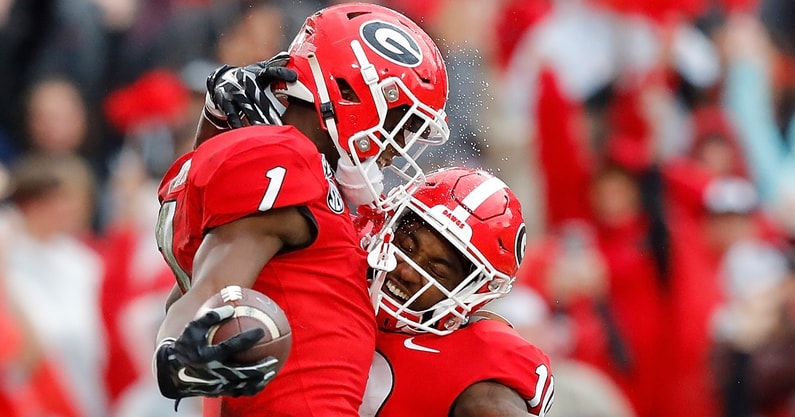What the BCS Top 25 standings would look like ahead of Week 6 of college football

Entering the sixth full week of the 2021 college football season, the national contenders are becoming more clear. While there are still a few weeks to go before the country gets its first look at the College Football Playoff rankings, the old Bowl Championship Series system provides some insight into what the rankings would have looked like during that era, which lasted from 1998-2013.
From BCS to CFP
Prior to the current CFP system, college football was governed by the BCS, whose final rankings were computer generated, and two teams faced off in the national championship to conclude the season. The system also created matchups for four additional prestigious bowl games: the Fiesta Bowl, Orange Bowl, Rose Bowl and Sugar Bowl.
The BCS formula used a number of factors to produce its list. There were three components to the rankings, with a mix of human and computer generated thoughts: the Harris Poll, the Coaches Poll and the computer rankings. All three parts were weighted equally.
The Harris and Coaches Polls had values assigned to each spot in reverse order. For example, in the Harris Poll of 25 teams, the top team receives 25 points, the second team receives 24 points, etc. The Coaches Poll had a similar scoring system, although there were fewer voters involved.
The third part, the computer rankings, included six additional polls: Anderson & Hester, Richard Billingsley, Colley Matrix, Kenneth Massey, Jeff Sagarin’s USA Today and Peter Wolfe. In the end, the final values assigned to each team in the three categories are averaged, and the BCS rankings were produced.
Beginning in 2014, the CFP replaced the BCS. Two semifinal games are played around New Year’s Day, and the games take place on a rotating basis at six of the country’s top bowls – the Cotton Bowl, Fiesta Bowl, Orange Bowl, Peach Bowl, Rose Bowl and Sugar Bowl. The two winners advance to the College Football Playoff National Championship. That game is played on a Monday night in the second week of January.
The CFP selection process is more subjective than the BCS, as the teams are decided upon by 13 people and there is no longer a strict computer component. The selection committee is composed of athletic directors, former coaches and student-athletes, and others in the college administration world. The current chair of the committee is Gary Barta, the athletic director at Iowa.
“The selection committee ranks the teams based on the members’ evaluation of the teams’ performance on the field, using conference championships won, strength of schedule, head-to-head results, and comparison of results against common opponents to decide among teams that are comparable,” the website says.
Additionally, there is a board of governors made up of presidents and chancellors from the 10 FBS conferences plus Notre Dame which governs the administrative actions of the CFP.
Top 10
- 1New
Jaxson Robinson injury
UK star to miss Tennessee game
- 2Trending
DJ Durkin
Auburn DC gets extension
- 3
AP Poll controversy
New Top 25 raises eyebrows
- 4
Penn State police warning
Saquon celebration triggers warning
- 5
Kai Trump
President's granddaughter holds $1.2M NIL Valuation
Get the On3 Top 10 to your inbox every morning
By clicking "Subscribe to Newsletter", I agree to On3's Privacy Notice, Terms, and use of my personal information described therein.
Alabama is the reigning national champion and holds the most CFP wins at eight. In total, the SEC and the ACC each have eight playoff appearances, driven largely by Alabama and Clemson’s near-constant presence at the top in recent years. Technically, all FBS teams have equal access to the playoff; there are no automatic qualifiers.
College football remains the only college sport in the country without an officially NCAA-sanctioned championship. At its core, the CFP is really a television contract currently owned by ESPN.
The first CFP rankings will be released on Nov. 2, but for now, here is a look at how the BCS rankings would currently look after Week 5:
- Alabama (5-0)
- Georgia (5-0)
- Iowa (5-0)
- Penn State (5-0)
- Cincinnati (4-0)
- Oklahoma (5-0)
- Michigan (5-0)
- Ohio State (4-1)
- BYU (5-0)
- Oregon (4-1)
- Oklahoma State (5-0)
- Michigan State (5-0)
- Notre Dame (4-1)
- Kentucky (5-0)
- Arkansas (4-1)
- Coastal Carolina (6-0)
- Ole Miss (3-1)
- Florida (3-2)
- Auburn (4-1)
- Texas (4-1)
- Wake Forest (5-0)
- Clemson (3-2)
- NC State (4-1)
- SMU (5-0)
- Arizona State (4-1)
These BCS rankings and the current AP Poll are largely aligned. They have the same top-six teams, and aside from No. 25 Arizona State, no team is more than two places away from their current AP Poll ranking in the BCS rankings; ASU is No. 22 in the AP Poll. The only team in the BCS rankings that is not currently ranked in the AP Poll is Clemson. San Diego State holds the final spot in the AP Poll but is not ranked here.
While the SEC has seven teams in these rankings, all five of the Big Ten teams listed are in the top 12. The ailing ACC, whose only remaining undefeated team is Wake Forest and the conference does not have a marquee win, is not listed until No. 21, which is the Demon Deacons.
After a 24-13 victory at Notre Dame Stadium last weekend, Cincinnati could run the table and become the first Group of Five team to make the CFP. One of the teams in front of them will definitely lose this weekend, as Penn State travels to Iowa on Saturday. But the Bearcats still may need some help in the form of additional losses from the Power Five conferences to crash the playoff party.